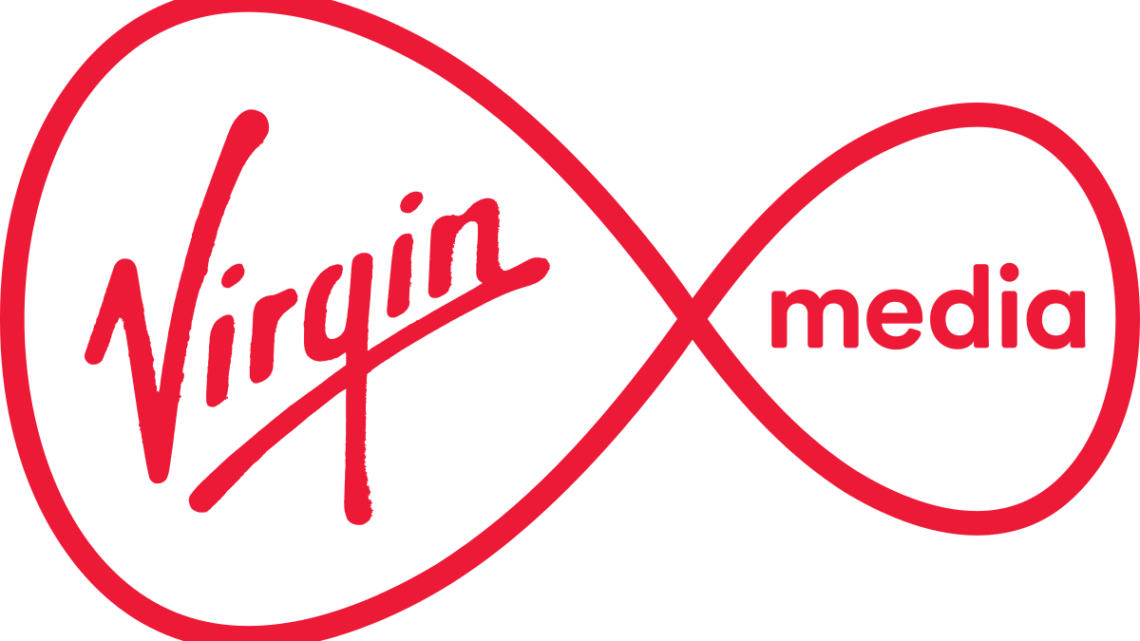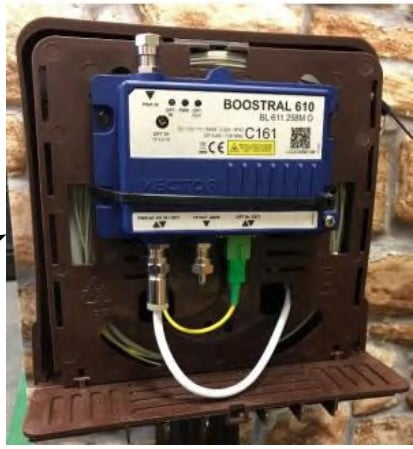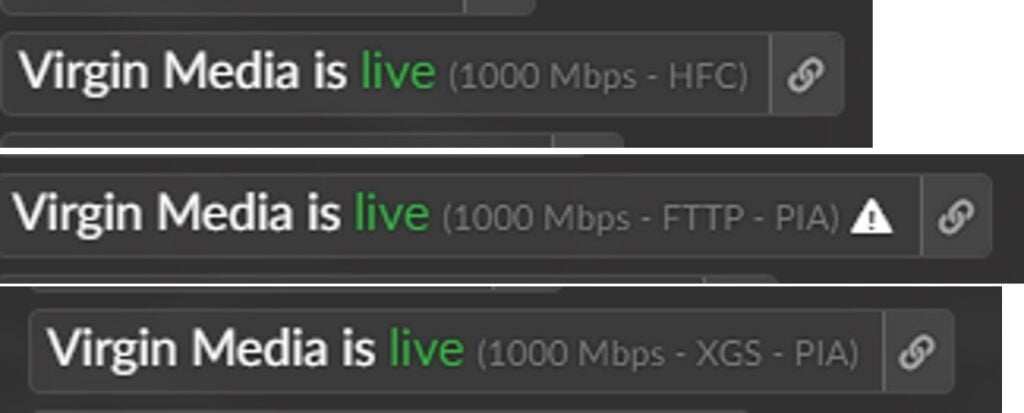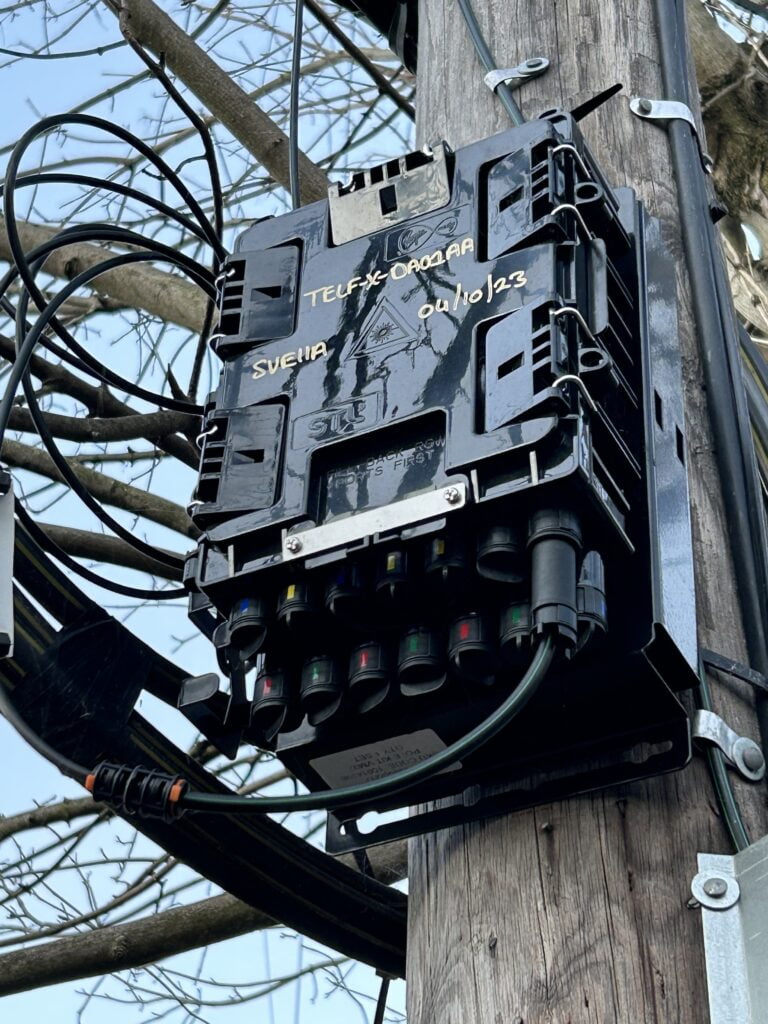
When you visit Virgin Media’s website to look at their broadband packages what is not obvious is there are three different ways the broadband will reach your home. In this blog we will cover the three types of Virgin Media Broadband.
Virgin now offer 2Gbps speeds and symmetrical connections but only in some areas using the latest technology.
If your thinking about getting Virgin Media you can get £50 cashback on all packages using our link.
Hybrid Fibre Coaxial (HFC)

The oldest and currently most common type of Virgin Media Broadband is delivered using what’s known as Hybrid Fibre Coaxial or HFC for short.
This is where Multi pair fibre optic cable is used from the nearest Virgin Media Hub or Headend to the
serving L3 fibre cabinet.
From the L3 cabinet high quality Coaxial cable is used for the rest of the journey though to the small street cabinets and into your home this could be up to 750M from the L3 cabinet to your home.
The technology used to deliver the broadband over the Coaxial cables is known as Data Over Cable Service Interface Specification (DOCSIS) and currently Virgin Media use DOCSIS 3.1 standard supports up to 10 Gbps download and 1 Gbps upload speeds.
At present Virgin Media’s fastest package available to HFC/RFoG customers is their GIG 1 which has a 1130mbps down and 104mbps upload.
Customers on the newer Nexfibre XGS-PON (more on that later) can now get Virgin’s new Gig2 (2Gbps download) package and Symmetric speeds.
As well as not being able to support the top Gig2 package and Symmetric speeds HFC and DOCSIS also has other drawbacks compared to the other types of technology Virgin Media use.
Latency is often higher compared to proper Full Fibre broadband and even Openreach’s hybrid copper offering Fibre to the Cabinet which uses copper telephone cables.
DOCSIS technology introduces overheads that can push latency higher and is often inconsistent and can suffer from latency spikes.
There have been plenty of Virgin Media customers complaining of this and that’s because high latency can make things feel sluggish even if you have a high speed connection.
Online Gamers will particularly feel the impact of a higher and inconstant latency connection.
The use of Coaxial copper cables while higher quality than the copper twisted pair telephone cables Openreach use will still have issues especially so in older build areas where the Coaxial may have been laid in the 1980’s.
In older developments the amplifiers that boost the coaxial signal may be underground which suffer from water ingress and attract Ants in the summer which cause the Amplifiers to overheat.
Cables will degrade over time all of this leads to poor performance and network outages.
Another common issue that plagues Virgin Media customers on HFC is congestion which particularly impacts peak times like evenings and weekends.
As the incoming broadband connection is Coaxial using DOCSIS there is no way of fully bypassing the provided Virgin Media hub as its needed at the very least to act as a modem to convert the DOCSIS into Internet.
You can in most cases put the Virgin Media Hub into Modem Mode which should allow you to use your own router.
This applies to FTTP – RFoG below.
FTTP - RFoG

Virgin Media stopped building HFC to new areas around 2020/2021 and up until 2023 was building their network using FTTP or Fibre to the Premise but not quite the same as FTTP from say Openreach.
Virgin Media first wave of FTTP installs bought the Fibre optic cable to the home then at the termination box outside used a box to turn the Fibre Optic light signal into electrical signals over Coaxial to feed into the home known as RFoG which stands for Radio Frequency over Glass.
In terms of Broadband in the home this is still presented over Coax to the same Virgin Media hubs using the same DOCSIS technology used in their HFC network above.
This means the same downsides and limitations of DOCSIS from above still apply.
What is different is DOCSIS aside it gets rid of any issues associated with Coaxial copper cables outside the home which should mean less issues overall.
It will also mean those property’s served by this type of FTTP RFoG can be more easily upgraded to XGS-PON in the future (more on that later).
FTTP - XGS-PON
The latest technology that Virgin Media use for their broadband is XGS-PON based FTTP.
This is a proper FTTP network where the fibre optic is used all the way to the router in Virgin Media’s case using their latest Hub 5x.
XGS-PON is a 10Gbps symmetric (same upload and download) capable technology and is used by most alt-nets for building FTTP networks.
Since around 2022/3 Nexfibre which is a joint venture between Virgin Media parent company Liberty Global and IfraVia have been building the new FTTP network with Virgin Media currently the sole ISP on the network.
This new XGS-PON powered network gets rid of any DOCSIS based issue and should behave the same way as any other FTTP based network.
As of 7th Feb 2024 Virgin have announced the launch of their Gig2 package which will for now be exclusive to XGS-PON Nexfibre areas.
The new package offer download speeds of 2Gbps and 200Mbps upload by default.
As well as the new Gig2 package Nexfibre XGS-PON areas will be able to get symmetric speeds across all the packages for an extra monthly cost.
This means Nexfibre XGS-PON areas now get a speed advantage over HFC/RFoG areas.
The big difference that can be felt for XGS-PON users and may be a downside is for TV packages you can only get these using Virgin Media’s Stream box as without Coaxial there are no traditional cable television signals just internet.
This is the way TV seems to be going though with Sky pushing their similar Sky Stream service where the TV is delivered over internet.
At the time of writing (July 2024) it should be noted that the Virgin Media Hub 5x does not support modem mode aka ip passthrough which means if you want to use your own router the only official way currently would be to double NAT which can cause issues.
You may have some luck like I did getting it to work see how I did in my blog here
Alternatively there is a way to bypass the Hub 5x using a SFP+ module.
I have had Virgin Media XGS PON FTTP installed (nexfibre network) the video above shows the install you can also read parts 1-3 of my blogs with my review video of the service shown below:
How to tell which type your on?
You may be wondering how you can tell which type of Virgin Media you have (or can get ) well if your a current Virgin Media customer then its quite easy to tell between XGS-PON and HFC/RFoG.
If your Virgin Media Hub/Router connects using a coaxial cable which screws into the back of the router then your not on XGS-PON.
XGS-PON customers will have a 5X Hub model and the fibre optic cable will connect into he back of it (as pictured above).
Another way to tell and which is also handy if your maybe looking to see what broadband options are available is using the Better Internet Dashboard.
On the Better Internet Dashboard enter your house number and postcode then if Virgin Media is live it will show you which technology is being used at your address:

You will see the tree types in brackets next to Virgin Media is live.
HFC being Hybrid Fibre Coaxial the first one we covered above.
FTTP will be the 2nd type we covered the RFoG which still uses DOCSIS
XGS is the XGS-PON FTTP we covered last which is the latest type of technology Virgin Media use.
The PIA in the examples above relate to if they used Public Infrastructure Access aka sharing Openreach’s existing Poles and ducts to build their network.
This does not really matter as its the technology type that really makes the difference.

By 2028 it will all be XGS-PON
If your currently in an area stuck on HFC or RFoG FTTP types don’t worry as Virgin Media have announced they plan to upgrade all areas of their network to XGS-PON FTTP by 2028.
This will mean at that stage all Virgin Media areas will be equal and will be able to enjoy multi gig and symmetrical speeds.
Even more good news is once on XGS-PON FTTP the network can be easily upgraded in the future to faster technology’s like 50G-PON as the fibre optic cables in the ground remain the same it will be the boxes either end of the network that would need to be changed.
With the move to XGS-PON based FTTP it will also mean Virgin Media will be using the same technology as the majority of other alt-nets and a better technology than Openreach which still use older GPON.
With the latest Nexfibre expansion Virgin Medias coverage will grow to millions more homes including more rural areas for the first time.
thanks for all this info its an excellent resource. Is there any way to find out when virgin will upgrade our area to XGS? we currently have Rfog and as a gamer the latency issues you talk about are my man concern to switching. We dont have FTTP available either so im stuck on a 70mg BT connection for now 🙁
Hi Ted thanks for reaching out.
I’m afraid Virgin are being tight lipped when it comes to upgrading existing HFXC/RFoG areas you could try emailing them to see if they can provide any ETA’s.
If your really struggling with speed you may find the RFoG is ok maybe see if anyone nearby has the RFoG service and get them to run some latency and speed tests to see if its acceptable?
Latency on FTTC can also be hit and miss.
Interesting article, mate. I wonder why they bothered with the halfway house of the FTTP-RoG installs? Perhaps they’d decided that there was no point doing HFC anymore but they didn’t have much of a supply of the newer modem/routers and TV boxes?